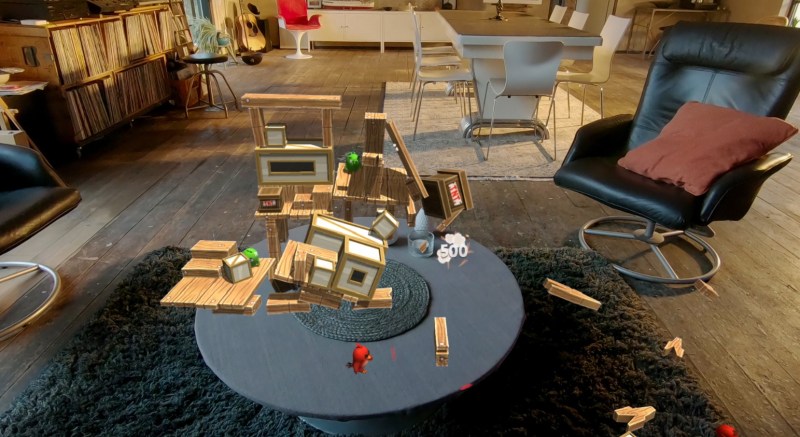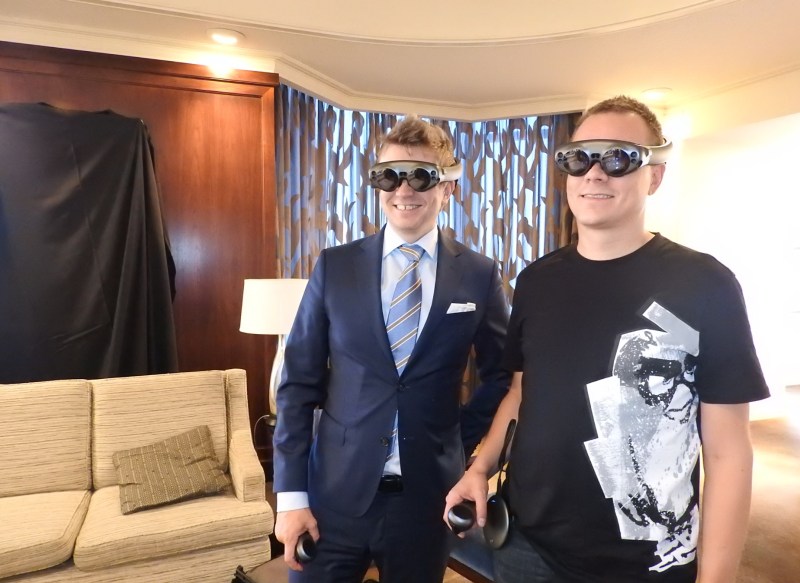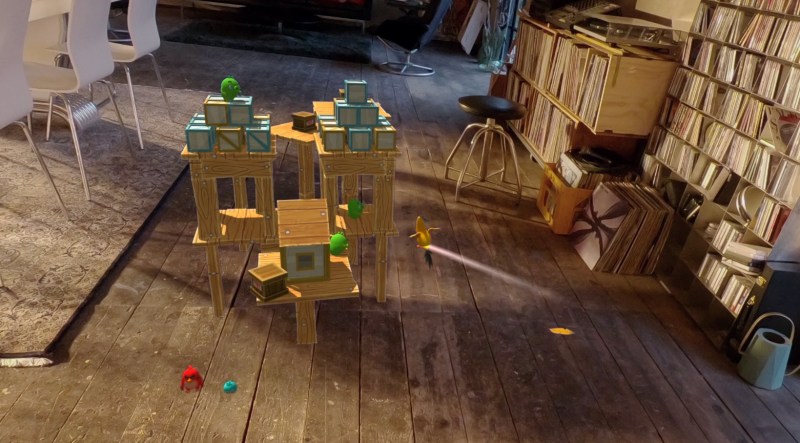Rovio Entertainment and Resolution Games have launched their augmented reality game Angry Birds FPS: First Person Slingshot on the Magic Leap One Creator Edition glasses.
It’s one of the showcase demos on the Magic Leap headset, which I tried out a few weeks ago for the first time. Plantation, Florida-based Magic Leap has a lot riding on cool demos like this one, as it has raised $1.8 billion to date to build its $2,295 AR glasses. The Angry Birds app is one of many that Magic Leap is unveiling at its L.E.A.P conference in Los Angeles today and tomorrow.
As I noted in my preview, this Angry Birds plays just like any other version of the game that originally came out in 2009 and has accumulated 4 billion downloads since. But this game adds a see-through augmented reality effect and 3D spatial gameplay. You can place the virtual fortresses of the green pigs on a real-world table and then walk around it, viewing it from 360 degrees.
When you find the right vantage point and target, you squeeze the trigger on the one-button controller, pulling back your virtual slingshot. Then you let go and a bird shoots out at the target, knocking down some of the blocks on the table. You can’t help but crack up when you see this happen for the first time. The birds chirp and the pigs grunt, and it’s like playing Angry Birds again for the first time.
June 5th: The AI Audit in NYC
Join us next week in NYC to engage with top executive leaders, delving into strategies for auditing AI models to ensure fairness, optimal performance, and ethical compliance across diverse organizations. Secure your attendance for this exclusive invite-only event.

Above: When you fire an Angry Bird at a pig fortress, the blocks come crashing down around your living room.
You can take your time when you aim. You squeeze the trigger to pull the slingshot back. The bird in the slingshot will look back at you. In front of you, as you look through the Magic Leap goggles, you’ll see the virtual game superimposed on the real world. When the blocks fall, they take into account the landscape and physics of the real world. So most of the blocks will fall down onto the real table, but a few will fall off the edge to the floor of your own home. Magic Leap calls the blending of the physical world and digital overlay “mixed reality.”
If you point your bird at a pig, the pig will start cowering with fear. Your object, as in the original game, is to shoot a bird at a key point in the fortress and trigger a Rube Goldberg-style effect that brings everything down and pops all of the green pigs. You can aim a yellow bird at the wooden blocks and knock them out or shoot a red bird at a box of TNT to set off an explosion.
“It’s great to offer Angry Birds fans a completely new and unforeseen way to play the beloved Angry Birds,” said Kati Levoranta, CEO at Rovio Entertainment, in a statement. “Resolution Games has done an excellent job at developing the Angry Birds to Magic Leap One. We’re always looking for opportunities to expand to new technologies and platforms, and Angry Birds FPS is an exciting step forward into the future of gaming.”
Stockholm-based Resolution Games, cofounded to do virtual reality and augmented reality games by Candy Crush Saga leader Palm, built the game in close collaboration with Helsinki-based Rovio.

Above: Tommy Palm, CEO of Resolution Games, and Sami Ronkainen, Rovio creative director, show off the Magic Leap One Creator Edition.
“Rovio has established an incredibly successful and beloved entertainment franchise with Angry Birds. By taking Angry Birds to Magic Leap’s spatial computing platform, we’re giving fans one of the most engaging, interactive and immersive experiences possible,” said Tommy Palm, CEO of Resolution Games, in a statement. “It really is quite remarkable that in 2018 we’re able to use full spatial gameplay and light field technology to enjoy these classic game mechanics and characters in our own environments. Angry Birds FPS: First Person Slingshot demonstrates the true impact mixed reality technologies can have on the games industry.”
Resolution Games has also built other virtual reality and augmented reality games such as the fishing game Bait!, Bait! Arctic Open, Wonderglade, Narrows, and Solitaire Jester. But this is the first game that the team built on Magic Leap, which debuted its Creator Edition in August in limited markets.

Above: Angry Birds on Magic Leap.
“What’s going on with Magic Leap One Creator is we’re going to have those pockets of people who want that right now. They’ll start living 10 or 20 years ahead of everyone else,” said Rony Abovitz, CEO of Magic Leap, in an interview with GamesBeat in August.
The gameplay is actually different from a two-dimensional version of Angry Birds that we’ve all played on our smartphones. Since the pig fortress is in 3D, you have to walk around the entire structure, as it sits on a table, in order to see exactly where the weak points of the structure and where a well-aimed bird can cause a domino effect that brings the structure down.
Sometimes, when I made a bad shot, the pigs would snicker and mock me. But once in a while, I would shoot at one object, knock it down, and then trigger an unintentional collapse of the entire structure. When my companions heard that big crash, they knew that I had made a good shot and yelled some encouragement..
The game is available for free, as it is meant to show off exactly what the Magic Leap goggles can do.
The graphics looked quite convincing, as the slingshot would obscure the view of things that were behind it in my field of view. The blocks did the same. However, the blocks and other things “sitting” on the real table do not cast shadows, as you can see in the image. That limits the realism of the virtual layer on top of the real world. Over time, this kind of thing can change.

